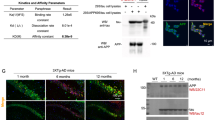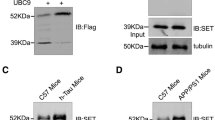Summary
The carboxyl-terminal amino acids 272–299-truncated apoE4 (Δ272–299) is the main fragments of apoE4 hydrolysate in neurons. The effects of truncated-ApoE4 (Δ272–299) overexpression on tau phosphorylation in cultured N2a cells were investigated. The truncated-apoE4 (Δ272–299) cDNA was subcloned into pEGFP-c3 to form recombinant pEGFP-T-apoE4. pEGFP-c3, pEGFP-T-apoE4 and pEGFP-apoE4 were transfected into N2a cells respectively by lipofectamine 2000 method. After 24–48 h, tau phosphorylation was detected by Western blot assay and glycogen synthase kinase-3 (GSK-3) activity by using GSK-3 activity assay. The results showed that the overexpression of both full length-apoE4 and truncated apoE4 fragments in N2a cells induced a dramatic increase in phosphorylation of tau at Ser202 sites and the activation of GSK-3 as compared with untransfected cells, most significantly in the cells transfected with pEGFP-T-apoE4 (P<0.05). It as concluded that in vitro overexpression of truncated-ApoE4 (Δ272–299) can result in tau hyperphosphorylation in N2a cells by activating GSK-3, suggesting truncated-ApoE4 (Δ272–299) might contribute the pathogenesis of Alzheimer disease.
Similar content being viewed by others
References
Fagan A M, Holtzman D M. Astrocyte lipoproteins, effects of apoE on neuronal function, and role of apoE in amyloid-beta deposition in vivo. Microsc Res Tech, 2000, 50 (4): 297–304
Hans H. Bock, Yves Jossin. Phosphatidylinositol 3-kinase interacts with the adaptor protein Dab1 in response to Reelin signaling and is required for normal cortical lamination. J Biol Chem, 2003, 278 (40): 38 772–38 779
Huang Y D, Liu X Q. Apolipoprotein E fragments present in Alzheimer’s disease brains induce neurofibrillary tangle-like intracellular inclusions in neurons. Proc Natl Acad Sci USA, 2001, 98 (15): 8838–8843
Han X L, Cheng H. Novel role for apolipoprotein E in the central nervous system. J Biol Chem, 2003, 278 (10): 8043–8051
Cedazo-Minguez A, Popescu B, Blanco-Millan J Met al. Apolipoprotein E and beta-amyloid (1–42) regulation of glycogen synthase kinase-3beta. J Neurochem, 2003, 87 (5): 1152–1164
Ye S M, Huang Y D, Mullendorff Ket al. Apolipoprotein (apo) E4 enhances amyloid peptide production in cultured neuronal cells: ApoE structure as a potential therapeutic target. PNAS, 102 (52): 18 700–18 705
Kosik K S. The molecular and cellular biology of tau. Brain Pathol, 1993, 3 (1): 39–43
Goedert M. tau protein and the neurofibrillary pathology of Alzheimer’s disease. Trends Neurosci, 1993, 16: 460–465
Pei J J, Tanaka T, Tung Y Cet al. Distribution, levels, and activity of GSK-3 in the Alzheimer disease brain. J Neuropathol Exp Neurol, 1997, 56: 70–78
Author information
Authors and Affiliations
Additional information
Zhou Jie, female, born in 1976, Lecturer, M. D., Ph. D.
This project was supported by two grants from National Sciences Foundation of China (No. 30470348 and No. 30570554).
Rights and permissions
About this article
Cite this article
Jie, Z., Juan, C. & Youmei, F. Effect of truncated-ApoE4 overexpression on tau phosphorylation in cultured N2a cells. J. Huazhong Univ. Sci. Technol. [Med. Sci.] 26, 272–274 (2006). https://doi.org/10.1007/BF02829548
Received:
Issue Date:
DOI: https://doi.org/10.1007/BF02829548




